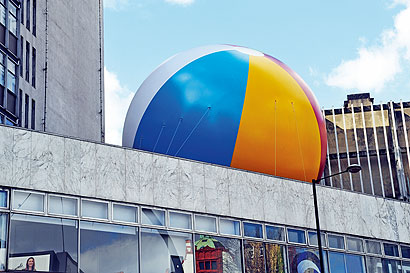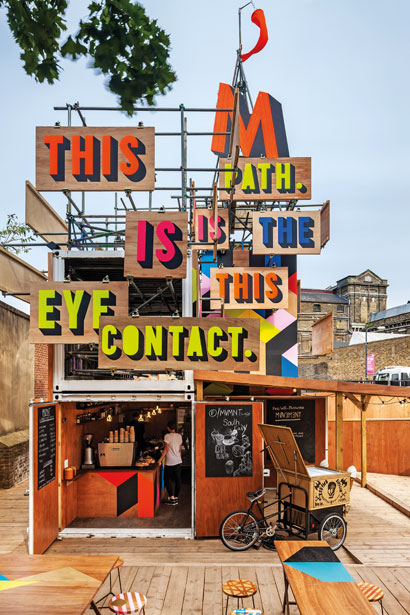|
Morag Myerscough in her studio |
||
|
In the first of a series of talks hosted by the Design Museum, in association with Icon, the London-based designer discusses her approach to “playful placemaking” with Owen Pritchard Black neon orange black naples yellow black neon pink reflex blue white violet gold vermilion very pale yellow” – 12:28pm, 30 March 2014. “It’s a secret,” says Morag Myerscough with a smile. “All will be revealed soon though.” The London-based, self-styled placemaker is referring to her Twitter feed, which for the past few years has been sporadically announcing streams of colours and nothing else. There are around 2,000 tweets at the time of writing. Whatever the outcome may be, the exercise neatly sums up the designer’s modus operandi – her work makes places pop through a combination of colour and words.
Myerscough’s use of colour is about as subtle as a punch in the face, and builds on the tradition of Bridget Riley, Jamie Reid, Roy Lichtenstein and Jenny Holzer. Her uncompromising approach demands a unique primal response – exploring our highly subjective response to colour and language. For Myerscough the goal is, simply, “to connect”. Since she founded Studio Myerscough in 1993, her work has become increasingly familiar and has won numerous awards. “I feel really lucky,” she says, reflecting on her career so far. “When Luke [Morgan] and I did Her House [their gallery in Hoxton, east London], I thought, ‘Why didn’t I do this before?’ I filled a space with my own work.”
Royal London Hospital children’s ward, Whitechapel, 2013 Currently, Myerscough is occupied with a number of projects, many at the planning stage. She is part of one of the teams – working with long-time collaborator Allford Hall Monaghan Morris – that are developing a design for a pavilion at the 2015 Milan Expo. With Supergroup, a loose group of frequent collaborators, she is looking to work with the Southbank Centre for this summer’s Festival of Love and is preparing another pitch for an arts festival in Graz. And her designs for the windows of John Lewis on Oxford Street will be unveiled in May as the department store celebrates its 150th anniversary. “What I try to do is to connect the people who use the buildings,” she says. “It is absolutely about working out what people will respond to.” In London her work can be seen at the Stirling Prize-nominated Kentish Town Health Centre, where giant illustrations of medical equipment soar up the walls, clearly stating where the centre’s different functions can be found. At Westminster Academy (another AHMM building), the massive atrium explodes with colour, while her wayfinding system of massive arrows at the Barbican helps visitors to make sense of the baffling layout.
Westminster Academy, London, 2007 One of Myerscough’s most endearing spaces can be found in east London, hidden in the PFI behemoth that is the Royal London Hospital. On the children’s ward she, along with Vital Arts, has turned an anonymous atrium into a fantastic play space with oversized stuffed animals. The corridors are transformed from sterile, purgatorial spaces by colourful murals inspired by her home city. “I come from Holloway, I love London. I love the diversity. I didn’t want to do a children’s ward like you often find,” she says. “I really like being given something with nothing in it: I ask, ‘Who is this for and what can I add to the environment?”
Discovery Pavilion, Birmingham Central Library, 2013 It is in London, too, that Myerscough is undertaking one of her most unlikely collaborations, creating the exhibition for the permanent collection of the Design Museum. This will occupy the top floor of the refurbished Commonwealth Institute, a project led by the architect John Pawson, whose minimalist approach could not be further from Myerscough’s. “I like that juxtaposition,” she says. “There is the Pawson aesthetic, the original aesthetic, and us on the top floor. We have been through many iterations, which is interesting because when I design exhibitions there is usually an 18-month lead, with maybe six months of intense work.” Reflecting on the project in particular, she adds: “Temporary I can do. Permanent comes with a weight on the shoulders.” Her recent temporary projects include the Discovery Pavilion, which was installed on the ground floor of the new Birmingham Central Library, and the Movement Cafe in Greenwich. Both were wooden constructions adorned with colourful typography and patterns.
I Get Around, Old Street, London, 2013 “I make places that can be taken over by the people that use them. The Discovery Pavilion’s interior was really bare. Whoever came in could make it their own. There were some great transformations of that space. Better than I could ever do.” When asked how she places herself between architecture, art and design, Myerscough is sceptical of the way that design is classified. “Design shouldn’t be divided into so many categories, but expertise should be shared. But then certain disciplines think that they are in control or know better.” (We both mouth the word “architects”.) “Designers should be more than just the supporters of things.”
Movement Cafe, Greenwich, London, 2012 During last winter’s storms, Myerscough’s installation at Old Street roundabout, I Get Around, found itself in the national news. The work, a giant beach ball, came loose from its tethers and bounced down the road, bumping into the Bezier apartment building: a splash of colour against a passive, monochromatic facade. It is hard to think of an image that better captures Myerscough’s work. For tickets to the Design Museum’s 25th anniversary talks series visit DM25.org |
Words Owen Pritchard
Portrait Joe McGorty
|
|
|
||
























